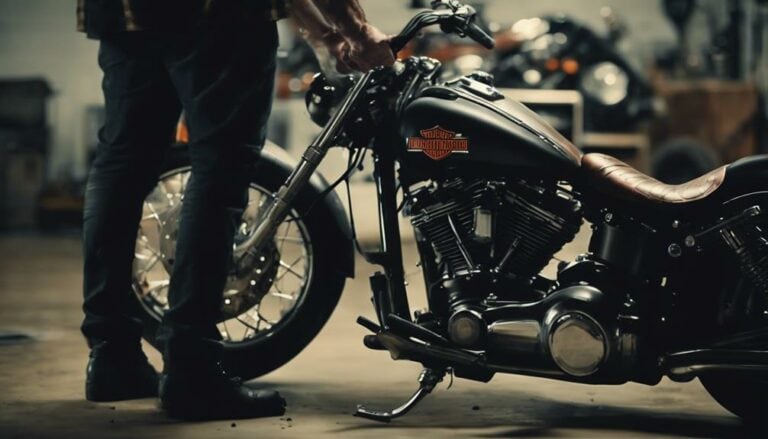When it comes to valuing your used Harley Davidson, remember that not all chrome glitters the same. Determining the true worth of your beloved bike involves a blend of research, market awareness, and strategic choices.
But what about the sentimental value that often comes with owning a Harley? How do you balance that emotional attachment with a fair price tag that reflects its actual market value?
Let's explore the key considerations and expert tips that can help you navigate this valuation journey smoothly and confidently.
Key Takeaways
- Consider modifications: They can impact value by 10%-30%.
- Research pricing: Use KBB, NADA, and Harley-Davidson resources.
- Understand seasonal trends: Prices vary throughout the year.
- Emphasize maintenance: Well-kept bikes fetch higher prices.
Utilizing Online Pricing Resources
When determining the value of your used Harley Davidson, begin by utilizing online pricing resources to gather comprehensive data on the market trends and pricing information. Websites like Kelley Blue Book provide valuable insight into the trade-in value and suggested retail price of Harley-Davidson motorcycles. NADA also offers a range of prices including Suggested Retail, Low Retail, and Average Retail values, giving you a detailed understanding of the market. Additionally, the official Harley-Davidson website offers general price points for newer models, further aiding in your valuation process.
ChopperExchange Pricing Tools are another useful resource as they allow you to compare prices with sold motorcycles, enabling you to determine a more accurate market value for your used Harley-Davidson. By utilizing these online resources, you can gain a comprehensive overview of the pricing landscape, helping you make informed decisions when buying or selling a Harley Davidson motorcycle.
Considering Modifications and Customizations
To accurately assess the impact of modifications and customizations on the value of your used Harley-Davidson, it's crucial to understand how these alterations can influence the overall market worth of your motorcycle. Here are some key points to consider when evaluating customizations on your Harley-Davidson:
- Customizations can impact the value of a Harley-Davidson motorcycle by 10%-30% based on the extent of modifications.
- Upgrades may not significantly increase the dollar value of the bike, as some modifications may not add substantial resale value.
- Certain motorcycles should be kept in original condition to retain their value, as not all modifications enhance the bike's overall worth.
- The return on investment for modifications on a Harley-Davidson motorcycle is generally minimal, with limited impact on resale value.
It's essential to carefully consider any modifications you make to your Harley-Davidson, as not all customizations increase the value of the bike. Be strategic in your choices to potentially retain or enhance its overall worth.
Conducting Research on Various Platforms
For comprehensive valuation insights on your used Harley-Davidson, explore various platforms to gather pricing data and comparisons.
Start by checking Kelley Blue Book for the trade-in value and suggested listing price of your motorcycle. NADA also offers valuable information, providing Suggested Retail, Low Retail, and Average Retail prices to help you accurately assess your bike's worth.
Additionally, visiting the official Harley-Davidson website can give you an idea of general price points for newer models. Utilize ChopperExchange Pricing Tools to compare prices with recently sold motorcycles, giving you a real-time view of the market.
Remember to consider any upgrades or modifications you've made to your bike, as these can impact its pricing. By conducting thorough research on these platforms, you'll be better equipped to sell your bike and attract potential buyers looking for a fair deal.
Understanding Seasonal Pricing Trends
Explore how seasonal pricing trends affect the value of your used Harley-Davidson, offering insights into optimal selling times and potential cost savings based on market dynamics. When considering the best time to sell or buy a motorcycle, understanding the seasonal price fluctuations can be advantageous. Here's a breakdown to help you navigate Harley-Davidson pricing trends:
- Summer: Prices tend to be higher due to increased demand and favorable riding conditions.
- Spring: Pricing may vary as sellers prepare for the upcoming riding season, impacting market dynamics.
- Fall: Demand starts to decline, leading to gradual price adjustments for Harley-Davidson motorcycles.
- Winter: Prices are typically at their lowest point, especially in colder regions where riding activity decreases.
Moving Forward With Your Valuation
Consider evaluating your used Harley-Davidson by taking into account factors such as age, model, and overall condition to determine its market value accurately. A well-maintained bike in good condition will typically fetch a higher price than one with visible wear and tear. Highlight any custom features or upgrades, as these can increase the value by 10%-30%.
Providing a detailed service history and maintenance records showcases the care taken with the motorcycle, potentially boosting its perceived value. When moving forward with your valuation, seek professional services or reputable online resources like KBB for precise pricing information. It's essential to research market trends, seasonal fluctuations, and competition to set the best selling price for your used Harley-Davidson.
Conclusion
As you navigate the intricate world of valuing your used Harley Davidson, remember to steer clear of the choppy waters of over-modification and instead, cruise smoothly with originality and market-savvy strategies.
By revving up your research engines and fine-tuning your selling approach, you can ensure a transaction that purrs like a well-oiled machine.
Embrace the journey of valuation with confidence and precision, and watch your Harley Davidson ride off into the sunset of a successful sale.

